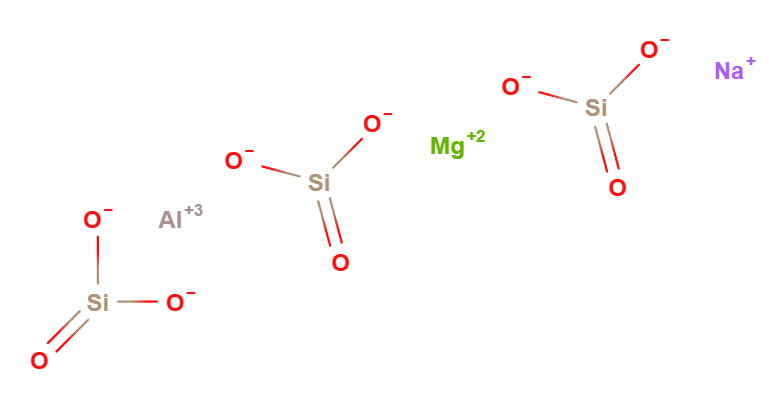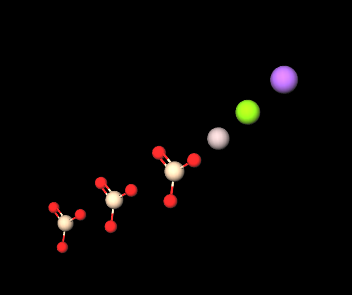| "Descrizione" by admin (19549 pt) | 2023-Dec-10 16:32 |
Sodium Magnesium Aluminum Silicate è un composto chimico, silicato complesso risultante dalla reazione del silicato di sodio e dell'alluminato di sodio in una soluzione acquosa di nitrato di magnesio. E' utilizzato in vari settori, tra cui cosmetici, prodotti per la cura della pelle e industria.
Il nome definisce la struttura della molecola
- Sodium Magnesium Aluminum indica che il silicato in questione contiene sodio, magnesio e alluminio nella sua struttura. Questa combinazione di elementi conferisce al composto proprietà uniche, come una maggiore capacità di assorbimento e di opacizzazione.
- Silicate si riferisce ai silicati, una classe di minerali che contengono silicio e ossigeno, spesso in combinazione con altri elementi.
Materie prime utilizzate nella produzione.
Sodio, magnesio, alluminio, silice, minerali argillosi come montmorillonite o bentonite.
Processo di sintesi chimica industriale passo per passo.
- Estrazione di minerali argillosi. I minerali come la bentonite o la montmorillonite, ricchi di silicati di sodio, magnesio e alluminio, sono estratti dal suolo.
- Purificazione. I minerali estratti vengono purificati per rimuovere impurità e contaminanti.
- Idrolisi. La silice viene fusa con idrossido di sodio, generando silicato di sodio.
- Reazione con Magnesio e Alluminio. Il silicato di sodio viene poi fatto reagire con sali di magnesio e alluminio per formare il silicato di sodio, magnesio e alluminio.
- Precipitazione e Filtrazione. Il composto risultante viene fatto precipitare, separato e quindi filtrato per ottenere un prodotto puro.
- Essiccazione. Infine, il composto viene essiccato per rimuovere l'acqua residua e ottenere la forma solida di Sodium Magnesium Aluminum Silicate.
Si presenta in forma di polvere bianca.

A cosa serve e dove si usa
Cosmetica
Assorbente. Assorbe sostanze disperse o disciolte in soluzioni acquose, acqua/olio, olio/acqua.
Sicurezza
L'alluminio può interferire con diversi processi biologici (stress ossidativo cellulare, metabolismo del calcio, ecc.), quindi può indurre effetti tossici in diversi organi e sistemi ed il sistema nervoso è il principale bersaglio della sua tossicità.
E' da considerare con attenzione il rischio del cumulo di assunzione di alluminio, che non può essere escluso in quanto questo ingrediente può trovarsi sia in prodotti cosmetici che in prodotti alimentari a largo consumo come pane, vari prodotti da forno (1).
Applicazioni commerciali
Cosmetici. Il Silicato di Sodio Magnesio Alluminio viene utilizzato come agente opacizzante, stabilizzante e per migliorare la texture in vari prodotti cosmetici e di cura personale come fondotinta, creme e lozioni.
Agente opacizzante. Aiuta a dare ai prodotti una finitura opaca.
Stabilizzante. Aiuta a mantenere la stabilità della formulazione.
Miglioratore di texture. Rende i prodotti più cremosi e spalmabili.
Applicazioni Industriali. Questo composto viene utilizzato anche in alcune applicazioni industriali come agente stabilizzante o addensante.
Settori Farmaceutici e Medici. In alcuni contesti, può essere utilizzato come excipiente o agente di scorrevolezza nelle preparazioni farmaceutiche.
 |  |
- Molecular Formula AlMgNaO9Si3
- Molecular Weight 302.53 g/mol
- CAS 12040-43-6
- UNII
- EC Number 234-919-5
- DTXSID70890672
Synonyms:
Sodium magnesium aluminosilicate
Bibliografia_____________________________________________________________________
(1) Tietz, T., Lenzner, A., Kolbaum, A.E. et al. Aggregated aluminium exposure: risk assessment for the general population. Arch Toxicol 93, 3503–3521 (2019). https://doi.org/10.1007/s00204-019-02599-z
Abstract. Aluminium is one of the most abundant elements in earth’s crust and its manifold uses result in an exposure of the population from many sources. Developmental toxicity, effects on the urinary tract and neurotoxicity are known effects of aluminium and its compounds. Here, we assessed the health risks resulting from total consumer exposure towards aluminium and various aluminium compounds, including contributions from foodstuffs, food additives, food contact materials (FCM), and cosmetic products. For the estimation of aluminium contents in foodstuff, data from the German “Pilot-Total-Diet-Study” were used, which was conducted as part of the European TDS-Exposure project. These were combined with consumption data from the German National Consumption Survey II to yield aluminium exposure via food for adults. It was found that the average weekly aluminium exposure resulting from food intake amounts to approx. 50% of the tolerable weekly intake (TWI) of 1 mg/kg body weight (bw)/week, derived by the European Food Safety Authority (EFSA). For children, data from the French “Infant Total Diet Study” and the “Second French Total Diet Study” were used to estimate aluminium exposure via food. As a result, the TWI can be exhausted or slightly exceeded—particularly for infants who are not exclusively breastfed and young children relying on specially adapted diets (e.g. soy-based, lactose free, hypoallergenic). When taking into account the overall aluminium exposure from foods, cosmetic products (cosmetics), pharmaceuticals and FCM from uncoated aluminium, a significant exceedance of the EFSA-derived TWI and even the PTWI of 2 mg/kg bw/week, derived by the Joint FAO/WHO Expert Committee on Food Additives, may occur. Specifically, high exposure levels were found for adolescents aged 11–14 years. Although exposure data were collected with special regard to the German population, it is also representative for European and comparable to international consumers. From a toxicological point of view, regular exceedance of the lifetime tolerable aluminium intake (TWI/PTWI) is undesirable, since this results in an increased risk for health impairments. Consequently, recommendations on how to reduce overall aluminium exposure are given.
Wong, W.W., Chung, S.W., Kwong, K.P., Yin Ho, Y. and Xiao, Y., 2010. Dietary exposure to aluminium of the Hong Kong population. Food Additives and Contaminants, 27(4), pp.457-463.
Bratakos, S.M., Lazou, A.E., Bratakos, M.S. and Lazos, E.S., 2012. Aluminium in food and daily dietary intake estimate in Greece. Food Additives and Contaminants: Part B, 5(1), pp.33-44.
| Evaluate |

